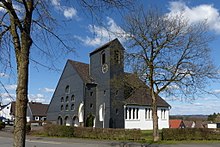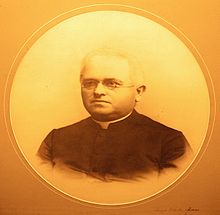Grunewald (Wermelskirchen)
Grunewald is a rural district of Wermelskirchen in North Rhine-Westphalia and is located in the former municipality of Dabringhausen .
history
The first mention of Grunewald can be found in 1669. Thirteen courts in the parish of Dabringhausen were defiant to the court court in the Herzogenhof in Odenthal. Henrich Zugel zu Grunewald and Catharina Kleys were named, married people who bought a share in an estate near Bergisch Gladbach. If this means the Grunewald near Dabringhausen (and not the Grunewald farm near Bergisch Gladbach-Herkenrath), it can be assumed that the living space existed as such.
Dabringhausen-Grunewald is also mentioned variously in the sources of green or green forest.
At the imperial headquarters in Burgos, Napoleon issued an edict on November 14, 1808 to examine and reorganize the territorial division of the Grand Duchy of Berg .
chapel
On Napoleon's orders, the then Maire Clarenbach may have drawn up a report for Dabringhausen in the Cönemühle. His investigation of November 8, 1809 was found in the State Archives in Düsseldorf. In it he made the proposal to build a small chapel halfway between the two places for the 200 Catholics in Dabringhausen and Dhünn. In addition to the costs, he asked for a reasonable contribution from the government, or at least for approval for a collection in the entire Grand Duchy of Berg. So far, the local Catholics would have walked over an hour and a half to Wermelskirchen, Altenberg, Bechen or Kürten. He suggested finding a retired clergyman from the repealed order who would take credit for preaching the gospel in such a position. He went on to write, “Any honest Lutheran would also acknowledge the gratitude of the most gracious government for this charitable institution. Because the Catholics don't have a church here, they don't stay here much. There is a lack of workers as well as professionals. As a result, however, many of them would be able to settle there if a service were arranged for it ”.
Certificates and cards
Dabringhausen-Grunewald was averaged out in a mapping from 1808 as the location for the construction of a chapel. Grunewald is also mentioned in a document in 1812 before notary Hamm in Wermelskirchen. Johann Wilhelm Altstadt, zu Grunewald, Mairie Dabringhausen, borrows 247 francs. This means the Grünewald in the Niederhonschaft Wermelskirchen (today Burscheid-Hilgen, Kölner Straße 32). In the Müffling map from 1824-25 an entry for Grunewald is missing, as are the older maps, starting with Ploennies 1715, Wiebeking 1789, LeCoq 1805. In the original cadastral map from 1828 the house was still missing and was only revised around 1884 when the old map was revised was added in red ink. In the Prussian map v. Delius from 1844 then finds an entry Grunewald for the first time on a map with two buildings. 1869 on the map of the Lennep district there are two buildings and the chapel.
Donation for a mission chapel
During this time the long-planned chapel building was also started. On July 28, 1867, August Siefer and his wife Louise Oerder, Schirpendhünn, donate to the Catholic community of Wermelskirchen (represented by Pastor Heinrich Draf, Rendant Friedr. Dorrenbach zu Oberstraße, Friedr. Graef zu Kallenberg, Joh. Keller zu Born, Pet. Schmitz Ellinghausen, Pet.Schmitz zu Wermelskirchen, the latter four as members of the church council) in front of Notary Diekhoven zu Hückeswagen, three acres of arable land in corridor 2, parcel 550/393, called Ledderfeld, to set up a mission station , the property is worth 360 Taler.
The first service was held on September 7th, 1867 in the hall of the purchased inn at Grunewald. The Archbishop of Cologne, Paul Melchers , founded the Mission to Grunewald behind Irlenweg, as a branch of the Catholic parish of Wermelskirchen. He appointed the young priest W. Bruns as rector of this position. A chapel was then built, which was to serve as a school and as a principal's apartment at the same time. In 1868 it was ceremoniously opened for its purpose. The church room was so small that the school room next to it had to be used on Sundays.
Donation for the churchyard
In 1868 the Siefer couple also donated 60 rods of wood on the Chaussee from Bechen to Hückeswagen, located in corridor 2, parcel 540/406 to create a churchyard for the Catholic Church. Mission, worth 45 thalers, with the condition to be able to build a fenced in family burial place on it. Heinrich Förster and his wife Caroline Bürgel had already erected a large cross in the later cemetery in 1856. It still stands today and was renovated in 2008. There were landowners with the name Förster in Dabringhausen in 1830 and 1866 in Eulen near Kürten and in Oberpilghausen. It could also have been a wealthy tenant on the Große Ledder or on the large Roelscheid farm. Both are nearby. The founders of the chapel, the Siefer couple, were buried in the new cemetery in 1894 and 1900.
church
Due to the restless activity of the rector Bruns, a beautiful church made of quarry stone was built in later years, plus a suitable rector's apartment and an apartment for the sexton. The old chapel was then still used as a school (see picture postcard with a view of the town and detailed photos of the church and school).
Inn
The first secured document mentioning Grunewald is found in 1832. In that year, a Caspar Heinrich Sichelschmidt loaned 565 thalers to the newly built house in the Grunewald near Großeledder. Two years later he borrowed another 700 thalers, on the cadastral article 356, with the house on plot 413, hall two. Probably in order to add to the great hall, he borrowed another 1500 thalers in 1841 on house no. 155, in article 356. Perhaps he had taken over, at least Caspar Sichelschmidt sold his property in 1853 to the married couple Johann Peter Engels and Ida Engels nee Johann. The angel calls himself a farmer and trader, it is not known whether he was also an innkeeper. When the cadastre was revised in 1866, Johann Peter Engels, zu Grünenwald, owned the cadastral article 92, large 26 acres, with a house in corridor 2, plot 413.
The married couple Johann Peter Engels and Ida Johann sold the inn in Grunewald in 1868 to the farmer August Siefer and his wife Louise Oerder, Schirpendhünn, for 4600 thalers. They ceded the purchase price claim to the archbishop's chair in Cologne. August Siefer provided his Schirpendhünn estate as a caution. The house was then associated with the Oerder, Siefer, Enkler and Büchler families until 1926.
The first local chronicler in Wermelskirchen, main teacher Peter Joseph Heinrichs, drew the chapel and the inn in 1876 and had them lithographed by A. Henry in Bonn. Unfortunately, there is no original of the drawing in Henry's estate in the Bonn City Archives. When Josef Greitemann bought the inn from Hubert Büschler and his wife Anna Oerder in 1929, the picture was still there in the guest room. In today's restaurant this image has been preserved up to our time. The former chapel opposite has now given way to a new building (see picture at the very beginning), which not only replaced the chapel (later school), but also the first church that was built afterwards.
literature
- Breidenbach, NJ (Ed.), Dabringhausen Grunewald - Contributions to the history of the parish of St. Apollinaris and the place of residence, Verlag Gisela Breidenbach, Wermelskirchen 2010, ISBN 3-9802801-9-5
Individual evidence
- ↑ Jux, A., Botenamt Gladbach, pp. 408f
- ↑ Scotti, Laws ..., Vol. II, p. 1151, No. 3030
- ^ Landesarchiv NRW Main State Archive Düsseldorf (HStAD) Grand Duchy of Berg, No. 9963
- ↑ a b c d HStAD, Notary Hamm Rep. 230/263, 7039, 8286, 11561
- ↑ a b Landesvermessungsamt Bonn 1987 and HStAD LA Lennep 449
- ↑ Berg district cadastre. Gladbach
- ↑ a b HStAD, Rep. 5738/1492, 319, 329
- ↑ a b Breidenbach, Family property and taxes ..., Wermelskirchen 2004
- ^ HStAD, Notary Reichmann Rep 394/3108
- ↑ History & Homeland, RGA No. 3/2006





